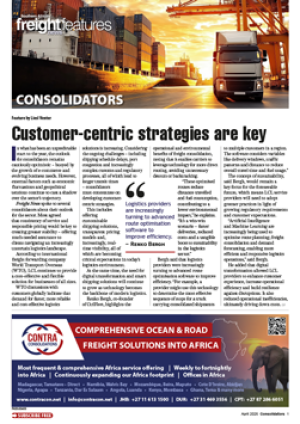South African logistics companies and importers selling into the rest of the Southern African Development Community (SADC) should be planning for major shifts in trade f lows due to improved port, rail and road infrastructure in the region, advises Duncan Bonnett, director of Africa House South Africa.South Africa is “losing its footprint in southern Africa and southern central Africa, where we are traditionally the gateway”. This trend is already evident.According to the African Export-Import Bank’s Africa Trade Report 2024, in 2023, South Africa’s share of total intra-African trade stood at 20.4%, down from 21.4% in 2022.While over 29.6% of South Africa’s total exports were to Africa, the bulk went to neighbouring countries, led by Mozambique and followed by Botswana, Zimbabwe, Namibia and Zambia.Revolution in logisticsSouth African gateway routes are being replaced by a “revolution in logistics which started happening just pre-Covid and has since a ccelerat ed ”.Global companies such as DP Word and MSC, which previously had a limited footprint in Africa, have taken over the running of container terminals and are spending “hundreds of millions of dollars” upgrading them.Almost every major port in the region, outside of South Africa, from Banana in the Democratic Republic of Congo (concessioned to DP World) to the Kenyan Ports Authority (currently in the process of concessioning ports) is now run by private companies, he points out.“Since it was concessioned, Maputo has more than trebled its throughput, and most of that increase has been at the expense of South African ports. “If you go back 10 years, probably between 85 and 90% of all the copper cathode produced in Zambia and the DRC was exported through South Africa. “Today it is around 35%, with the rest going out through Dar es Salaam, Beira or Maputo. With Lobito coming on stream, we will lose even more of that share.”Switch to Lobito possibleMines, manufacturers and traders in the DRC and Zambia will switch to Lobito to save costs and reduce their carbon footprint, predicts Bonnett.He is supported by Michael Henning, general manager of Easyclear, who told Freight News “as the east and west corridors and port infrastructure improve on the African continental trade routes, so I believe we will see a decrease in southbound volumes as South Africa starts to lose its strategic advantage as acontinental logistics distribution hub. This is compounded by the inefficiencies of our ports due to infrastructure challenges”.According to Bonnett, when the Kolwezi to Lobito link is fully functional, it will take seven to eight days to move cargo by rail, with one border post. Between Kolwezi and Durban it is anything between 30 and 35 days, going through four countries.In addition to the higher fuel costs, insurance companies charge a premium for high-value cargo going through South Africa due to the risk of theft, civil unrest and the burning of trucks.Furthermore, the industrialised world is decarbonising, despite the actions of the Trump administration. Rail between the Copperbelt and Dar es Salaam, Beira or Lobito has a much lower emission footprint than road. SA needs new approachBonnett says a “multipronged approach” is needed to ensure that South Africa retains as much of the volumes of regional imports and exports as possible. He says that while the three million tons of copper exports that could be lost is a small percentage of the cargo being carried by South African operators, it places South African exporters at a disadvantage because transport costs will increase.“What the upgrades to ports and landside links on the east and west coasts mean is that manufacturers and exporters based in Gauteng will become isolated.“It is the backhaul that is important. If you are carrying three million tons of copper out of the Copperbelt, you will want to take back three million tons of chemicals, reagents and equipment.” ER

